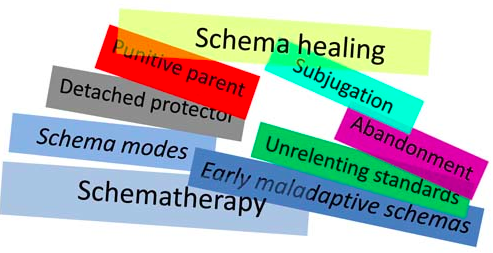When your core emotional needs are met in childhood, you grow up with positive life themes such as high self-worth and a belief in your ability to cope. Negative life themes emerge when your core emotional needs are not met earlier in life and these negative themes continue into adulthood. These negative life themes are also called schemas, which include your core beliefs about how you view yourself, others and the world. When schemas get triggered by situations that cause you to have social anxiety, then you go into negative patterns of behavior with a focus on avoidance.
Categories of Schemas
Schemas fall into five categories:
- Disconnection and Rejection schemas make it difficult for you to develop healthy relationships. These schemas are at the core of social anxiety because they prevent you from social connection.
- Hypervigilance and Inhibition schemas cause you to focus on avoiding failure or mistakes. With social anxiety, you fear judgment and being perceived as a failure or saying the wrong thing.
- Impaired Autonomy and Performance schemas make it hard for you to develop a strong sense of self and function independently. If you fear judgment by others, then you may avoid showing your true self.
- Other-Directedness schemas lead you to prioritize the needs of others above your own. When you surrender to other peoples’ needs, you often are passive about expressing your own needs.
- Impaired Limits schemas can lead to lower self-control and respecting the boundaries of others. These schemas are less common with social anxiety because you may be on the more inhibited end of the spectrum.
Common Schemas with Social Anxiety

While there are 20 schemas (including two new ones), there are six negative life themes that are common among people with social anxiety. Here are the most common ones:
- Social Isolation: Feeling alone and different from other people.
Social isolation is the feeling that you are different from other people. You may think you’re weird, odd or strange and you think others see you as socially awkward. This schema can result in great loneliness if you do not feel like you fit in with other people or groups.
- Failure: Thinking you are inadequate in your accomplishments compared to others.
When you feel like a failure, you believe you are not performing as well as others in areas such as career, school, relationships or other life domains that are important to you. You may believe you are less talented, intelligent or successful than others and view yourself as inadequate or incompetent.
- Defectiveness: Feeling shame because you think you are unworthy or flawed.
When your defectiveness schema gets triggers, you have a feeling that you are bad, unwanted, unloved or inferior. You tend to focus on your perceived flaws and have a painful sense of shame about yourself. Some of your common core beliefs could be about being unlikable or unlovable.
- Emotional Constriction: Inhibiting your emotions, thoughts and behavior due to shame.
When emotional constriction pops up, you keep your emotions tightly inside of you and have difficulty expressing your feelings and needs. You can be overly rational and invalidate your emotions. You suppress both positive and negative emotions like anger as well as joy, affection or warmth.
- Emotional Deprivation: Believing you can’t get support and connection from others.
When emotional deprivation gets triggered, you can feel like something is missing and that no one will ever care for you. As a child, your needs for affection, attention and closeness may not have been met. Your emotional needs may have been ignored, leaving you feeling misunderstood and empty, even as an adult.
- Unrelenting Standards: Being demanding and perfectionistic with yourself and/or others.
With unrelenting standards, you have really high internal standards that you think you must meet and you fear criticism. You lean toward perfectionism, can be extremely detail-oriented, be overly concerned about time and efficiency or have rigid rules about how you or others should be.
What Happens When a Schema Gets Triggered
When a schema gets triggered, you will have automatic thoughts and reactions. The reactions tend to be in a few categories such as:
- Avoidance of your emotions and the situations that cause you to have anxiety. Most often, avoidance involves not engaging in social situations. It can also involve avoiding painful feelings by detaching through activities such as substance use, overeating, overworking or mindlessly surfing the internet.
- Surrendering to your schema and acting as if it is true. This can lead to feeling passive and sometimes having resentment.
- Overcompensating means doing the opposite of how you feel. If you feel inadequate, for example, you may overcompensate by overachieving.
How to Break Unhealthy Patterns

In order to break an unhealthy life pattern, you must understand what your typical reactions are and notice the pattern when it is starting. Then you can take action to change it. There are three main categories of strategies that can help you change your life themes.
Cognitive:
- Identifying your primary schemas and the core beliefs related to them.
- Noticing when a schema has been triggered and which negative thoughts and beliefs are activated.
- Talking back to the inner critic and reframing your negative thoughts and beliefs into more helpful ones.
Behavioral:
- Being aware of your behavioral reactions when a schema gets triggered so you can work on breaking the pattern especially when it comes to avoidance.
- Developing a fear ladder from easiest to hardest by rating how much anxiety you have in each situation.
- Gradually engaging in small experiments so you can see success as you do things that you normally fear or avoid.
Emotional:
- Understanding your needs and figuring out how to get them met in the present.
- Using your imagination to envision being kind to yourself and getting your needs met now.
With social anxiety treatment, one of the primary goals is letting go of avoidance. Try to look at the many ways that avoidance is getting in the way of your life goals. This may motivate you to work on changing your schemas and patterns.
If you suspect that negative schemas such as the ones addressed in this article are triggering your social anxiety, know that there is hope! If you are ready to make a change, consider finding a good cognitive-behavioral therapy (CBT) clinician to help. CBT offers several time limited evidence-based approaches to address your negative schemas and help you overcome social anxiety.
For more information on managing the impact that schemas have on social anxiety, see this NSAC page and this one.












